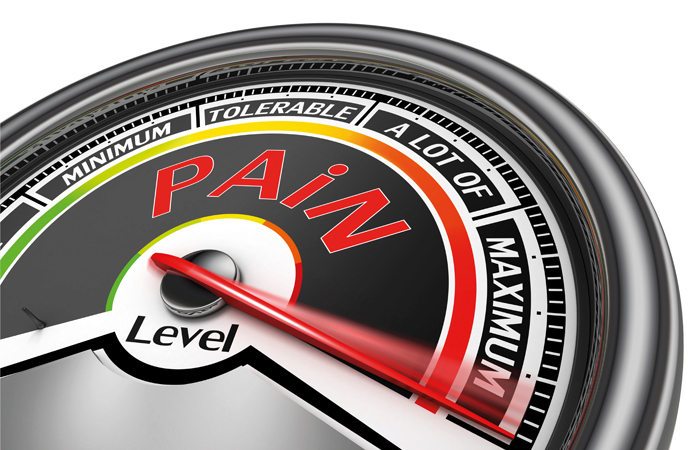OTC

What a pain
In OTC
Bookmark
Record learning outcomes
Helping customers to choose the right kind of treatment for their pain can be a tricky issue. Here, the experts provide answers to common queries
When pain strikes, people want to deal with it quickly, so a pharmacy is often their first port of call. But with so many different varieties of painkiller available, and so many different types of pain to contend with, customers don’t always know which product to choose. This is why pharmacy teams need to be able to answer queries about a whole host of pain-related problems and offer the right advice to suit customers’ individual needs.

Pros and cons
Pain can affect any part of the body and has a whole host of different causes and triggers. Some types of pain respond well to oral painkillers, while others may be managed better with a topical treatment. Some groups of people may need to steer clear of certain painkillers altogether.
“If a customer’s pain is associated with inflammation, such as back pain or headaches, paracetamol and anti-inflammatory painkillers work best,” says Neil Stewart, a pharmacist at Well. “If the pain is caused by sensitive or damaged nerves, as is the case with shingles or sciatica, it is usually treated with tablets that change the way the central nervous system works.”
However, Neil adds that all painkillers have potential side effects, so customers need to be made aware of the pros and cons, some of which are highlighted in the following questions.
Q: Can I use oral painkillers for osteoarthritis, and are these products safe to take regularly?
A: The first step in managing osteoarthritis is to try lifestyle measures, such as exercise. However, customers can take oral painkillers such as paracetamol or ibuprofen to ease their pain, as long as these don’t interact with any prescribed medicines they may be taking. If customers want to take these painkillers on a regular basis, it’s important that they know about the possible risks.
“Never exceed the recommended dose and be aware of possible side effects, especially with products containing ibuprofen, which is an anti-inflammatory,” says GP Dr Paul Stillman. “Ibuprofen has the potential to irritate the stomach and even cause bleeding, so customers should always take it with food and for short periods only. In fact, if customers need to take any non-prescribed medication regularly, they should see their doctor to check whether this is appropriate and to review their condition.”
Another option for customers with osteoarthritis is topical analgesics such as diclofenac. These can be rubbed into the affected joint to reduce pain and inflammation.
Natural remedies such as GOPO (which is derived from rosehips), glucosamine, chondroitin and fish oil supplements are an alternative choice. Some people find these very helpful for joint pain, although the clinical research results are mixed.
Q: When are topical painkillers likely to help with joint pain? Are they more effective for certain types of joint pain or certain joints?
A: Topical painkillers are available as rubs, creams, gels, sprays and patches. Most contain non-steroidal anti-inflammatory drugs (NSAIDs) such as ibuprofen or diclofenac and work by reducing inflammation. Others contain rubefacients, which create a sensation of warmth on the affected area.
“Anti-inflammatory gels have been shown to be useful in relieving pain in osteoarthritic joints, such as the knee, ankle, wrist and elbow,” says consultant rheumatologist Dr Rod Hughes. “Reviews suggest they seem to be more useful when used short term over two weeks, rather than longer, when they seem to lose their effect. Another pain-relieving cream, capsaicin, made from chili pepper extract, can help osteoarthritic pain, particularly in the knee and hands, but needs to be applied three or four times daily and is only available on prescription.”
If customers are using topical painkillers bought over the counter for more than a few days at a time, they should speak to their doctor to review their medication regimen.
Q: Can I buy something drug-free to ease my headaches?
A: Oral painkillers are effective for headaches, but over-using them can lead to rebound headaches and the risk of medication overuse headache. Customers may therefore prefer to try a drug-free approach, especially if they experience headaches associated with stress and tension.
“Lavender and cold pads provide short-term relief, and some people use feverfew [a herbal remedy], acupuncture, relaxation exercises or TENS machines, to name but a few,” says Dr Stillman. “There are many other products – for instance, using magnesium, thyme and rosemary oils or simple ice packs – for simple infrequent headaches.”
Dr Stillman adds that while we all have headaches and can usually treat them with confidence, we shouldn’t ignore them if they don’t go away. “If headaches persist and a customer doesn’t know why,” he says, “they must see their doctor.”

Q: What’s the best way to ease occasional migraines? Should I see my GP?
A: Occasional migraines may be triggered by certain foods, missed meals, weather changes, hormonal issues or stress, and they can often be treated with OTC medicines and self care measures. However, regular migraine attacks need GP advice and possibly a preventative treatment.
“For most people, early treatment is the key to success,” says Dr Stillman. “They may experience the feeling that a migraine is on its way, and that’s the time to do something. A common recommendation is to rest in a quiet, darkened room if they can. Paracetamol and ibuprofen can be very effective. Soluble painkillers may start working a little more quickly, and may be easier to take if they feel nauseous.”
Alternatively, if customers have been diagnosed with migraine by their GP, have their usual symptoms and fit the criteria for its use, they may be able to take OTC sumatriptan, a special type of painkiller that works by narrowing blood vessels in the brain, helping to relieve migraine and cluster headaches.
Q: I sometimes get mouth ulcers. What would you recommend to ease the pain?
A: Mouth ulcers are usually harmless, but they can be painful. Customers can try antiseptic or painkilling mouthwashes or mouth ulcer treatments. Karen Coates, dental advisor at the Oral Health Foundation, explains: “These act as a barrier over the ulcer to provide some relief. To speed up the healing and ease discomfort, customers should try to use warm salty water on the ulcer, as this can be a natural soother of the inflamed area. They should also try to avoid spicy or acidic foods, as these will cause more irritation.”
Karen adds that ulcers have a natural healing period, but if they persist for longer than three weeks, customers should seek further advice. “In extreme cases,” she says, “it could be an early sign of mouth cancer.”
Q: I have toothache and I’ve made an appointment to see my dentist. What can I use as pain relief while I wait?
A: Karen suggests that customers use a painkiller or anti-inflammatory while they wait to see their dentist. “Bathing the mouth in warm, salty water may also provide some relief from inflammation,” she says. “A cold compress on the outside of the face can help to reduce swelling.”
If a customer hasn’t yet made an appointment to see their dentist, they should be encouraged to do so. “Minor toothache can be due to food debris getting stuck between teeth or the start of a gum disorder,” says Dr Stillman. “Acute and severe toothache is frequently caused by an infection around the teeth, gums and even the jaw bones, or when a cavity develops in a tooth or if a filling in a previous cavity comes out, leaving the sensitive nerve to the tooth exposed. Clearly, this will not go away and needs expert attention.”
Q: Which OTC painkiller is most useful for period pain?
A: Period pain is caused by contractions in the uterine muscles. It is often felt as painful muscle cramps in the lower abdomen, which can spread to the lower back. Anti-inflammatory painkillers tend to be more effective than paracetamol, especially when used just before and during a period.
“Ibuprofen is usually effective, although alternatives like naproxen may be worth considering,” says Dr Stillman. “The pain usually lasts two to three days. If it is prolonged, or if the cycle is irregular or the bleeding is abnormally heavy or painful, this may be a sign of fibroids, inflammatory disease or other conditions like endometriosis. There are a number of prescription treatments that a doctor may recommend when simpler measures fail.”
Self care measures are important too. “Women should wear loose, comfortable clothing during their period,” says Neil. He also advises using a hot water bottle on the lower stomach and back to ease pain, and exercising to help clear out toxins from the muscles.

Q: I suffer from back pain. Will painkillers help or should I see a physiotherapist?
A: Steve Tolan, head of practice at the Chartered Society of Physiotherapy, says that painkillers won’t speed up a customer’s recovery from back pain, whereas seeing a physiotherapist will.
“Painkillers should only be used with other measures, such as exercise,” he says, “and even then just as a short-term option as they can bring side effects. Exercise, which is safer and cheaper, is considered the preferred option.”
Dr Stillman suggests topical remedies or back patches to provide targeted relief.
Q: I can’t take oral painkillers as they upset my stomach. What can you recommend instead?
A: Not all customers are able to take oral analgesics, so topical analgesics provide an alternative. “There has been a shift in expert opinion from oral medications to topical remedies,” says Dr Stillman. “One of the great things about using topical treatments, which often come in the form of gel, patches, cream or ointment, is that because they are used on one relatively small part of the body, very little of the active ingredients gets into the bloodstream. Therefore they provide targeted relief without the gastrointestinal side effects associated with long-term use of some oral pain relief.”
Q: How can I tell if I’m at risk of painkiller addiction?
A: If analgesics are used frequently to ease pain, rebound headaches can occur. This can lead to a condition called medication overuse headache. “Some research suggests that one or even two in every hundred people may be affected,” says Dr Stillman. “Abrupt cessation of the analgesic is the most effective treatment, but must be accompanied by temporary replacement therapy. Gradual reduction may be an option, but in any case, the treatment involved should be handled by a doctor skilled in the process. Overtones of drug abuse with all its stigma have dogged the reality of this condition for decades, and it is vital that all parties – patients, professionals, relatives and friends – approach it with an open and confrontational attitude.”
Recent research at the University of Derby identified two key questions that people can ask themselves to find out whether they are at risk of painkiller addiction. These questions are: ‘Would you be unwilling to reduce your pain medication?’ and ‘Do you feel you depend on your pain medication?’ “This can help people to know if they are really at risk, or whether they are worrying unnecessarily,” says James Elander, head of psychological research at the University of Derby. “If the answer to both those questions is ‘yes, definitely’, they should take steps to reduce their risk of addiction to painkillers. On the other hand, if it is ‘definitely not’, then perhaps they are more concerned than they need to be.”
Q: I suffer from chronic neck and shoulder pain. What’s likely to be the cause? Could a chiropractor help?
A: While oral and topical painkillers may provide some relief from chronic neck and shoulder pain, they won’t deal with the underlying cause. Rishi Loatey, a British Chiropractic Association chiropractor, says that chronic neck and shoulder pain could be caused by a large number of different problems affecting the joints, discs, muscles and nerves in the area. “It can even be as a result of long-term poor posture, or sitting in an uncomfortable position for long periods of time,” he says. “Chiropractors are trained to treat various conditions related to the spine. Most commonly, a chiropractor will offer manual treatments such as spinal manipulation, where they use their hands to move stiff joints. They will also suggest stretching exercises and lifestyle advice to help people with pain and to help prevent it recurring. Before starting treatment, a chiropractor will explain what is wrong, what can be done and what can be expected from chiropractic treatment. If a chiropractor doesn’t think someone can be helped by chiropractic treatment, they will be referred back to their GP, a consultant or to another healthcare professional.”
Oral painkillers are effective for headaches, but overusing them can lead to rebound headaches
